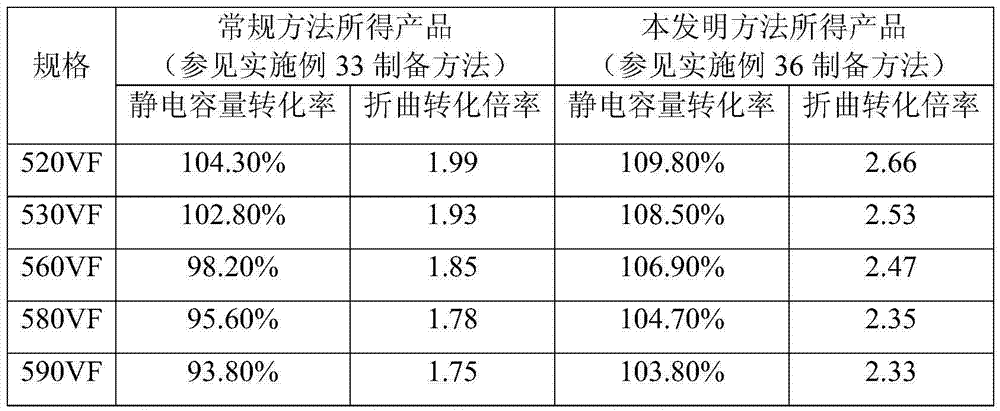High-conversion-rate formed liquid, formed foil and forming method thereof
A chemical conversion method and chemical liquid technology, applied in electrolytic coatings, surface reaction electrolytic coatings, electrolytic capacitors, etc., can solve the problems of low electrostatic capacity conversion rate, low bending conversion rate, etc. The effect of increasing the conversion rate
- Summary
- Abstract
- Description
- Claims
- Application Information
AI Technical Summary
Problems solved by technology
Method used
Image
Examples
Embodiment 1
[0038] The aluminum foil is sequentially subjected to A) first-level chemical formation, second-level chemical formation, third-level chemical formation, and fourth-level chemical formation; B) phosphoric acid treatment; C) heat treatment; D) post-chemical formation; E) post-treatment; treatment process parameters such as temperature , pressure, time, voltage, etc. are all parameters of conventional chemical formation methods; where:
[0039] The chemical conversion liquid used in the first-stage chemical conversion includes the following raw materials in weight percentage: 0.35% ammonium adipate, 0.20% citric acid, 0.003% maleic acid, 0.003% sodium hypophosphite, and the rest is water;
[0040] The chemical conversion liquid used in the second stage chemical conversion includes the following raw materials in weight percentage: 0.18% ammonium adipate, 0.15% citric acid, 0.002% maleic acid, 0.002% sodium hypophosphite, and the rest are water;
[0041] The chemical conversion li...
Embodiment 2
[0048] The method of formation is the same as the method in Example 1, except that the third-level formation and the fourth-level formation are used for the formation liquid:
[0049] The chemical conversion liquid used in the third-stage chemical conversion includes the following raw materials in weight percentage: 0.65% ammonium pentaborate, 0.015% azelaic acid, 0.030% citric acid, and the rest is water;
[0050] The chemical conversion liquid used in the fourth-stage chemical conversion includes the following raw materials in weight percentage: 0.65% of ammonium pentaborate, 0.005% of azelaic acid, 0.025% of citric acid, and the rest is water.
[0051] The electrostatic capacity conversion rate of the obtained formed foil is 102.50%, and the bending conversion ratio is 2.59 times.
Embodiment 3
[0053] The method of formation is the same as the method in Example 1, except that the third-level formation and the fourth-level formation are used for the formation liquid:
[0054] The chemical conversion liquid used in the third-stage chemical conversion includes the following raw materials in weight percentage: 0.65% ammonium pentaborate, 0.020% azelaic acid, 0.030% citric acid, and the rest is water;
[0055] The chemical conversion liquid used in the fourth-stage chemical conversion includes the following raw materials in weight percentage: 0.65% of ammonium pentaborate, 0.005% of azelaic acid, 0.025% of citric acid, and the rest is water.
[0056] The electrostatic capacity conversion rate of the obtained formed foil is 103.20%, and the bending conversion rate is 2.55 times.
PUM
| Property | Measurement | Unit |
|---|---|---|
| diameter | aaaaa | aaaaa |
Abstract
Description
Claims
Application Information
 Login to View More
Login to View More - R&D
- Intellectual Property
- Life Sciences
- Materials
- Tech Scout
- Unparalleled Data Quality
- Higher Quality Content
- 60% Fewer Hallucinations
Browse by: Latest US Patents, China's latest patents, Technical Efficacy Thesaurus, Application Domain, Technology Topic, Popular Technical Reports.
© 2025 PatSnap. All rights reserved.Legal|Privacy policy|Modern Slavery Act Transparency Statement|Sitemap|About US| Contact US: help@patsnap.com


